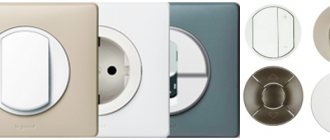A wireless light switch remotely turns on or off the light, changes the brightness of the light and controls the delay of operation of electric lamps.
Despite their higher cost, wireless switches have a number of advantages over their wired counterparts. They are ergonomic, have a stylish appearance and can be installed within a few minutes. There is no need to damage the walls, since these products are securely attached to the side of the cabinet, mirror, and other furniture.
Varieties
Modern wireless light switches are classified according to the following criteria:
- Number of controllable luminaires. There are wireless devices designed for one or more groups of lighting fixtures with different numbers of bulbs.
- Possibility of adjusting the luminous flux. The brightness of the lighting is adjusted by long pressing the button of the mechanism with a built-in dimmer.
- Management method. In stores there are designs with convenient touch or push-button switches and remote controls.
Using auxiliary functions allows you to configure the delay of command execution for some time. Then, before the lights go out in the room, the user can perform a number of necessary actions.
With remote control
Simultaneously with stationary switches, remote control of individual, multiple lamps is carried out from an ordinary key fob or remote control. At the same time, 2 buttons are allocated to each channel of the latter: one turns on the electrical power and increases the brightness of the light, the second reduces the light intensity and turns off electrical appliances.
Switching the load on and off is done by briefly pressing the button, and adjusting the light flux is done by holding it down for more than one second. The factory kit usually contains parts for wall mounting.
The presence of a remote control allows you to control the lighting in the house without going to the switches, without pressing them Source elektrikexpert.ru
Touchpad
It is a screen made of crystal glass. It has an image with a visualized backlight. Typically, switching is carried out by briefly applying a finger, lighting control is carried out by holding the latter on the marked area of the panel.
Subsequently, when a person touches the surface of the device, the parameters of the capacitor in the electric field change and a control signal is produced. It triggers the switching circuit of the switch. The absence of mechanical elements in such a design increases the reserve of its functioning to one hundred thousand inclusions.
The touch panel of the wireless switch is activated after lightly touching its surface Source ixbt.online
Multi-channel radio switch
Up to eight channels can be configured, all of them connected to one lighting system. Such a device makes it possible to regulate the light in all rooms of the building. It remembers the addresses of specific remote controls and executes commands only at the individual bitrate.
This design transmits and receives information at a specific speed (measured in kbit/s), and the signal frequency (about 35 kHz) does not change at all. The basis of any remote control is a pulse generator. Its notification is modulated by a specific indication code.
The range of the wireless radio switch is up to 250 meters, the battery charge is designed for 5-7 years of active operation Source bt-energy.ru
Connection
Let's look at the procedure for connecting a wireless light control device using the Zamel RZB-04 as an example.
The product package includes the following components:
- two-channel radio signal receiver;
- two-channel four-mode switch;
- fasteners for mounting the device (dowels with self-tapping screws, double-sided tape).
The receiver is capable of operating in one of five modes:
- Inclusion. When you press a button, one or more light sources are turned on. The function is available in any of the possible key positions.
- Shutdown. The function is also activated by pressing a key.
- Monostable mode. The lighting only works when the button is pressed. As soon as the key is released, the light goes out.
- Bistable mode. The light is turned on and off alternately by successive key presses.
- Temporary mode. After pressing the key, the lighting remains on for some time. The function is useful for lighting devices operating in entrances, bedrooms, and long corridors.
Before you start connecting the receiver, you need to understand the circuit.
Advice! If the receiver cannot be mounted in the ceiling, it is recommended to use a socket box or chandelier base for this purpose.
Connection instructions
We carry out the work in this order:
- Before starting work, turn off the electricity (using a machine) and check the network for no voltage. After this, remove the old switch.
- First, we apply voltage (connect phase and zero). We direct only the phase to the switch, but not the zero. It is necessary to obtain a phase that runs continuously and constantly supplies voltage to the receiver. To do this, turn on the transmitter or connect the conductors directly. The second option is more preferable. To create a continuous phase, we connect it to one of the conductors going to the lighting fixture. To make the connection reliable, we use Wago terminal blocks.
- We connect the phase to contact L. There is no need to pass the wire through the switch, since the device operates in constant mode.
- We connect zero to contact N. We take the wire from the junction box.
- To the OUT1 terminal we connect the phase wire going to one or more lighting devices. Here you will need a neutral wire, which we take from the junction box or receiver (pin N).
- We connect the phase wire to the OUT2 contact, going to the second group or one lighting device. We take the neutral wire in the same place as in the case of the OUT1 contact.
- We connect a pulse transmitter to the INT1 contact. This switch transmits only short signals when a key is pressed. As a result of operation, the operating mode of the first group of lighting devices changes. This feature of the pulse device allows you to control the lighting from a remote control or a stationary switch.
- We connect the impulse switch for the second group to the INT2 contact in the same way as described above.
- We connect the switch to the receiver and connect the electricity.
System programming and reprogramming
We decide on the operating mode of the system. Typically, consumers choose the standard option, which involves moving the switch to the upper position to turn it on (turning it off is done in the opposite direction).
To perform programming, perform the following steps:
- Using a screwdriver, press the PROG button of the ROP-2 device. Hold the screwdriver until the red LED lights up.
- Briefly press the top of the wireless radio switch button. As a result, the red diode will light up.
- We press the bottom of the switch and the light diode lights up again.
We reprogram the second key using the same principle as described above. The only difference is that the actions are performed with the second yet unused key.
Installation of the device
To secure the device, the supplied kit includes double-sided tape and dowels with self-tapping screws. The easiest way is to use tape, since in this case you won't need any tools. Another advantage of adhesive tape is the ability to change the location of the switch as many times as you like. The adhesive tape is divided into four sections, each of which is glued around the perimeter of the device.
When the switch is installed, install a control lamp. With its help we test the performance of the system. To check, move the key to the upper position - the light comes on. Press the down key and the lighting turns off. An indicator indicates that the switch has tripped.
Advantages and disadvantages
As practice shows, a wireless light switch is an extremely convenient design. Among its main advantages it is worth noting:
- simple installation that does not involve disturbing the finishing of the walls, chipping their surface, or laying additional wiring;
- the ability to control all lighting fixtures in the home using one control panel;
- large signal reception radius: 30-250 m, which depends on the product model, layout, load of furniture in the room;
- safety for residents: the device operates at a minimum current and in any case is not capable of harming human health.
The disadvantages of wireless devices include loss of control of the lighting system when the battery in the remote control is discharged or the Internet is disconnected (if WI-FI is used).
Wireless switches have no physical connection to switching units at all Source i.siteapi.org
Contactless module selection options
Control can be done using a remote control, which for convenience is made in the form of a key fob.
Before purchasing a contactless limit switch, you must pay attention to the following characteristics:
- block type - the external one can be installed in place of the standard device, the internal one is mounted after removing the chandelier;
- layout - the kit includes a remote control, charging, and rarely a battery and holder;
- features of lighting lamps - the devices are compatible with LEDs, halogens and incandescent bulbs;
- operating frequency – ranges from 2.2 to 5 GHz, which determines the quality of signal reception and transmission;
- range of action – budget models operate at a distance of 10 m, luxury models – at a distance from 100 to 350 m;
- power – contactless equipment has a maximum load limit of 1000 W, but you need to select a power unit with a power 20% more than declared;
- number of clicks – the battery runs out after 10-20 touches, the sensor is designed for the number of touches up to 100 thousand;
- current rating – from 6 to 16 A;
- number of channels - modern devices receive signals from 1-8 sources.
Important characteristics are also the case material, the presence of a coding system, the permissible temperature range of use and the method of fastening.
Application
It is advisable to purchase and then install wireless switches (instead of traditional devices), if necessary:
- Turning lights on or off at great distances. Installation of wiring is expensive, the radio switch (depending on the product) operates within a range of no more than 350 meters.
- Transferring any device. In order not to move bulky furniture and to avoid damaging the finish, the device can be installed on the wall, inside the cabinet.
- Elimination of installation defects. When moving the power line, there is no need to trench the walls; it will be enough to connect the mechanism with or without a remote control.
- Ensuring convenient use of electrical appliances. The contactless switch does not take up much space and is easy to operate.
- Control lighting throughout the house. A small functional device with a remote control provides the ability to control connected light sources from several zones.
- Saving the design idea. If the switch cannot be installed inside a niche, the wireless device will fit perfectly into any interior style.
Important! In wooden buildings, when flammable building materials are used inside the buildings, the laid cable significantly increases the likelihood of a fire. The use of distance structures will be the most economical and simple solution.
Modern wireless switches have a stylish appearance and can be installed within a few minutes Source elektrikexpert.ru
Smart home equipment for apartments: light control via the Internet
The availability of this method is based on the fact that the remote lighting control scheme is based on the use of devices that already work in most of our apartments.
State-owned information technology companies have long provided most residents with unlimited Internet that operates around the clock.
I purchased smart home equipment for an apartment in China from Sonoff. Next I show how the remote lighting control scheme works via the Internet from a smartphone.
The kit includes a Sonoff smart switch and a small key fob remote control.
In principle, all work via the Internet occurs through a smartphone, and the remote control is only needed to switch the lights inside the apartment. Although even in this case you can get by with your mobile phone.
It’s just convenient to keep the key fob remote control in one place; all family members, including children, can use it. In addition, it works regardless of the presence of WiFi.
Now I do not intend to fully describe the settings of the smartphone and the connection of its circuit to the smart switch, but will focus on the difficulty that I had to face when installing the module in the old installation box.
My apartment is located in a multi-storey panel building built in Soviet times. For electrical wiring, the factory immediately created channels for laying cables.
They are located at arbitrary angles, often in the most inconvenient places for installation: literally in the recess at the junction of the wall and the ceiling slab. A channel for switches or socket groups runs downwards from it obliquely.
The old switch connection diagram is based on breaking only the phase wire. Therefore, the zero potential is not drawn there.
However, a Sonoff smart switch without zero potential will not work. I had to pull it there through an inclined channel.
When I removed the old switch housing, I saw an ordinary aluminum noodle - 2 wires. Then he climbed into the junction box, if that’s what you can call the place where the slabs join, which was covered with small gravel with scraps of newspapers and pieces of concrete.
I saw a tangle of twisted wires and black electrical tape. The voltage indicator and digital multimeter helped quickly understand the purpose of each connection.
It turned out to be a problem to insert an additional core of zero potential. The crushed stone and cement dust firmly filled the entire space of the cable channel.
Even attempts to pass through this composition with a rigid steel wire were unsuccessful. And inside the room, cosmetic work was recently carried out and new wallpaper was installed. I didn't want to stir up any dirt.
I used the old trick:
- Turned off the light in the apartment panel.
- I taped a piece of copper cable with three cores to the lower end of the old two-core wire with strong electrical tape.
- I inserted pliers with long jaws into the ceiling cavity and clamped them with the top piece of aluminum noodles, because it is impossible to pull it there with your fingers.
- I began to little by little wind the wire onto the pliers and remove the debris that was coming out of the channel, afraid that it would break. But it worked out.
In this way, it was possible to pull a new cable through the littered main and remove several handfuls of small stones from it. Why were they put there? I don't have an answer to this question.
I hope that my experience will be useful to someone.
By the way, much of the equipment from Nootekhnika: Belarus also allows you to control the light remotely via the Internet from mobile devices in the same way.
What to look for during the selection process
Before you begin selecting a wireless switch, you should determine the number of lamp groups that the device will serve. The number of channels can vary from one to eight. Low power consumption of touch and button products in gentle standby mode guarantees long-term operation of the transmitter: battery replacement is not required for two to seven years.
Additionally, it is necessary to calculate the total power of the light sources planned for connection, then accordingly select a device with optimal technical characteristics. It is definitely worth considering that models using infrared rays operate only at a viewing distance of the receiver; at the same time, radio waves can bend around all sorts of obstacles and penetrate walls inside structures. For a private home, there is no need to purchase a transmitter with a maximum power of 10 mW and a range of 0.1 km. In this case, a distance of 30 meters will be sufficient.
Popular manufacturers
Wireless electrical equipment is produced by manufacturers from various countries:
- Wookee company - radio switches with/without remote control operate with 1–6 channels and a load in each line of 0.2–0.5 kW, the radio signal receiving unit is located in the installation box, the range is up to 30 m.
- NPP "Nootekhnika" (Republic of Belarus) - switches with a touch or push-button remote control for 1-3 channels are distinguished by excellent polymer quality, the products are equipped with a radio dimmer, the range is up to 50-100 m.
- COSO company (Holland) - the receiving part of compact radio switches is placed in a regular chandelier socket and works with high power consumers ≤ 3.5 kW, the remote control range is up to 30 m.
How to connect with your own hands
Typically, the dimensions of the receiving module do not exceed the size of a box of matches. Therefore, it is easy to place it in the installation box or other easily accessible places near the installation wires. It can also be mounted at the location of the old switch (the latter must be removed).
To correctly install a wireless switch, you need to use a simple connection diagram Source strojdvor.ru
According to safety precautions, the day before connecting a wireless device, it is extremely important to turn off the electricity at the distribution panel. Connect the device to the electrical circuit in the following sequence:
- Cut the phase wire suitable for the lamp, connect the ends to Lin and Lout (in the case of a single-channel product).
- In a multi-channel model, separate the phase, then connect it to the corresponding light bulbs through the output terminals L1out, L2out, ..., Lnout.
- The common zero N is applied to the lamp lamps through the output and input zero terminals.
The contactless switch can be attached using the following methods:
- For screws into the socket of an old device or into a newly created hole.
- Glue using double-sided tape (usually included in the kit) to facing tiles, wallpaper or any parts in the interior.
The installation process of a wireless switch is practically no different from the installation of a conventional switch, the only difference is that there is no need for wiring Source electrikmaster.ru
Operating principles of remote devices
Modern devices that turn on/off light at a distance usually operate on the basis of emitting/detecting waves of a certain frequency (sound, infrared, ultrasonic, etc.).
Such devices usually consist of two parts:
- A receiver on microcircuits, which is installed near a lighting fixture or mechanical switch connected by power wires.
- Remote control (remote control).
Let's take a closer look at the most common types of such devices.
Infrared controlled switch
This category of devices operates on the basis of an infrared wave emitter, which is remotely controlled from a special unit connected to an open circuit. This makes it possible to turn the lamp on/off using the remote control.
A number of manufacturers (BJC, Duwi, Simon, Steinel) have found a way to avoid this problem. The models manufactured by these enterprises are equipped with controllers that convert infrared radiation into a radio signal, which allows you to increase the range and overcome obstacles encountered along the way.
In some cases, commands transformed into radio frequencies are converted back to IR at the output, which is necessary to control certain types of devices (air conditioners). Another disadvantage is the insufficient range of infrared waves (up to 20 meters), which can be overcome by using repeaters.
Devices for controlling light via radio channel
Such devices are often included in Smart Home systems, but can be used independently. In radio frequency remote switches, the command transmission process is carried out using a remote control, the signal of which is transmitted to the controller responsible for controlling the light.
A special range of radio frequencies is allocated for the passage of information (usually 315, 433, 868 MHz). The power of radio transmitters for such devices is 10 milliwatts, which is regulated by law.
Despite the small indicator, the operating radius of the devices is quite extensive: in open areas it reaches up to 100 meters, and in spaces with obstacles – up to 25 meters.
Such a range of the device (it can be enhanced by repeaters and other devices), as well as the ability to overcome obstacles, are the main reasons for the prevalence of radio switches, which are used both in everyday life and in industrial and administrative institutions.
Scheme of operation of radio frequency devices
To transmit a radio signal, the following set of equipment is required:
- battery (regular batteries);
- remote controller connected to the load and network;
- a remote control that resembles a remote control for a video or television device. There are pocket mini remote controls or key fob devices with 2-6 buttons; Such devices are used to control a small group of devices.
The remote control controller is mounted in a wall, lighting fixture (chandelier glass) or under a suspended ceiling.
Such a device is compatible with various types of lamps: incandescent, halogen, fluorescent (regular and compact), conventional and linear LED, regardless of whether they are arranged singly or in groups.
With radio control, the signal is transmitted in the form of a packet of information: it contains a command, the address of the device to which the instruction is intended, as well as a checksum. Radio waves are received by all receiving devices at once, but due to the indication of the address, only the device for which the command is intended responds.
The transmitted checksum is used to verify information: the amount sent by the transmitter must match the number counted by the receiver. If the results are different, the device does not work.
For stable, error-free operation, each command is transmitted to the transmitters repeatedly (at least three times), which somewhat slows down the efficiency of the system. Radio switches usually also have a button that allows you to turn off the remote control and control the device manually.
Control by mobile phones or via the Internet
Modern devices may provide a function for adjusting lighting using a smartphone or mobile phone. In this case, control is carried out via the Internet using special applications that are installed on a smartphone or computer. Typically, the software is part of the kit included with the device upon purchase.
Such devices have a large, almost unlimited range, but require Wi-Fi or other access to the worldwide network. Using phones and smartphones, you can turn the light on/off, adjust its intensity, and set special modes for devices (standard, custom).
Devices for turning off lights, equipped with remote controls, may also have additional functions, which include:
- possibility of adjusting the level of lighting intensity;
- a specially installed stationary button that allows you to find a lost remote control;
- equipped with a timer, light or motion sensor.
It is only important to remember that each additional option increases the cost of the device.
Using sensors to control lighting
Various motion sensors for remote control of lighting are widely represented on the lighting market. The most common of them are infrared. They are devices that close or open the lighting circuit when the level of infrared radiation increases in their “visibility” zone. As soon as a person or animal whose body temperature is higher than the background temperature enters the sensor’s field of action, the light turns on. As soon as a person leaves the sensor’s coverage area or remains in a stationary position for several seconds, the light turns off. Motion sensors are most often installed in entrances, above the front door, and less often - inside the apartment.
Where to buy wireless switches
You can purchase wireless switches either in a specialized store or online in an online store. In the second case, the budget option for purchasing products on the Aliexpress website deserves special attention. For some switches there is an option for shipment from a warehouse in the Russian Federation; they can be received as quickly as possible; to do this, when ordering, select “Delivery from the Russian Federation”:
| Universal relay with a set of switches for wireless control | AXUS smart wall switch with Wi-Fi | Smart Wall Switch with Wi-Fi |
| Switches with remote control EsooLi | Wireless touch switches SMATRUL | Wireless switch with receiver |
Controlling lighting from your phone
At first, touch control of light was used only in conjunction with the construction of a smart home, however, nowadays you can find a special photo relay in any room. Automatic lighting can make a person's life easier. A multi-channel switchboard is capable of turning on the lighting of all rooms from one point.
Experts highlight the following advantages of a remote lighting control system:
- Control using radio waves can increase the security of the apartment. You can control the light from your phone, personal computer or using a timer. This will protect the apartment from intruders in the absence of the owners.
- Great savings in necessary materials. To run cables to the switches you need a lot of expensive wire. It will also need to be replaced over time. The electronic control system needs a small amount of wire.
- There is no dependence on the electrical power supply network. The multi-channel cabinet and circuit breakers are connected using radio waves, and all light control is carried out without connecting to a local network.
Such a control system is most convenient when it is necessary to control the lighting level in many places at the same time. It can be combined with a dimmer, which will provide the most comfortable lighting in the room.











